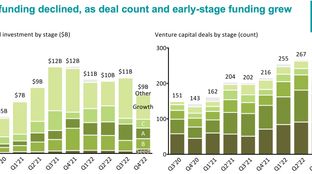In the early 2000s, concern around rising energy prices tied with rising emissions led to a wave of venture investors piling into cleantech almost overnight. The VC crusaders who rode the internet wave applied the same investment formula to what they saw as a disruptive market opportunity in clean energy. They poured billions into nascent clean technologies like thin-film solar, batteries, and biofuels, and waited for the sky-high returns that had been promised of the industry. Then unforeseen forces, such as advances in fracking and China’s manufacturing prowess, drove energy and solar PV prices way down, causing high-flying cleantech startups to topple one by one. The cleantech bubble burst, leaving venture capitalists with massive write-downs and scar tissue that hasn’t quite seemed to heal until now.
But if cleantech 1.0 was about energy and efficiencies, climate tech is about everything and evolution. The new dawn of climate tech is about acknowledging our planet’s hurtling trajectory towards an unlivable future, and rewiring the way we do things to get to any reasonable place. Amongst the euphoria of climate technology investment and the chase for the next Tesla, reality holds true that the dividends of innovation are measured in decades not SPACs. Here, we offer some reflections on how climate tech has evolved, where we are today, and some ways we may guide the future while heeding past missteps:
What has always been true?
- Climate is tech – climate is not a siloed thesis or niche; software ate the world, data models will run it, and organizations will need resiliency in capital, talent and infrastructure.
- Climate is measurable – values-based investing is now value-based investing. Climate change is tangible economically and locally, and companies will have to control for its impacts across their organizations, markets, and interdependencies.
- Climate takes a village – the transformation of the entire economy takes all hands on deck of top talent from technology and research, policy and governance, to operations and investment in order to drive more durable transformation.
So, what’s different this time? How is Climate Tech different from Cleantech 1.0?
- Climate Tech today is broader than Cleantech yesterday, and encapsulates decarbonization and adaptation of all sectors (buildings, mobility, ag, industrials, retail, etc.) vs. solely efficiency and use in the energy sector. Where CT1.0 approached climate investing looking for a silver bullet solution to our energy needs, climate tech approaches the problem with a million paper cuts across industries, asset classes, and functions.
- Climate change is now tangible to the economy and our lives. The climate crisis is at our front door. Whether by flood, fire, or freeze, the effects of climate change are now personal and accelerating. The number of extreme weather disasters grew 5x over the last decade, costing the US alone over $890b.
- Fundamental technology advances have driven down the cost of renewables, meaning lower capital intensity for climate tech. Solar costs have dropped 90% in the last decade, and solar and wind are now often the cheapest form of power with batteries tracing down the cost curve in hot pursuit. The dream of CT1.0 was cheap renewable energy, and these renewable technology advances are perhaps the biggest difference of the past decade, enabling the adoption of other climate tech built atop electrification as a path to decarbonization.
- Rigorous (inter)national climate policy means that 70% of the global economy has now committed to net zero – most within the past 12 months. During CT1.0 any hope of global climate cooperation let alone the Paris Agreement was distant on the horizon, and the US was stuck in a series of gridlocked doldrums on climate policy. Now the Biden administration is stacked with staffers already taking swipes at the $1.7 trillion climate plan through departments as diverse as agriculture, treasury, and the interior.
- Demand from public markets and institutional investors for ESG has handily doubled the past 5 years, with record inflows marking each quarter. The bigger-than-ever pool, plus the supply-demand imbalance between public ESG capital vs. private ESG companies and tools like SPACs to bridge the gap, are enabling climate tech business to make the leap over CT1.0’s Valleys of Death.
- Corporate decarbonization commitments are an entirely new change lever of the past few months – let alone decade. Whether from investor pressure, consumer demand, supply chain necessity, or talent attraction and retention, the world’s biggest corporates are tripping over each other on the race to carbon neutral / negative, waving their pocketbooks at startups for green RFPs along the way. Mega tech cos like Google and Microsoft, which had massive electricity-fueled carbon footprints, are now legacy climate neutral orgs and actively derisking the frontier of climate tech as initial adopters of carbon negative technology purchases.
What are we excited about? What’s unique and positive about Climate Tech investing today?
- Subsidy sober – climate tech businesses are learning to stand on their own with better performance and lower costs, without reliance on external factors such as rising oil prices, regulation, or subsidies to drive returns.
- Talent to climate – across industries, functions and tenure. Climate is no longer the province of crunchy do-gooders. As people increasingly want to align their values with their work, more top tier technologists, investors and operators are devoting their energies to the climate ecosystem.
- Custom structured funds – to fit climate tech long technology development timelines. Climate tech funds have much more patient capital, with LPs who know what they’ve signed up for (especially in moonshot funds like BEV). Deep technical diligence is also left to scientific and industry expertise, not just the software investors.
- Syndication and collaboration – between a spectrum of investment funds. Companies and projects have better access to the right capital at the right time as climate tech funds across multi-stages (seed venture to mature project finance) and multi-strategies (corporate VC to generalist) proliferate. Financial and strategic value-add is generated through an investment ecosystem willing to work together – whether through sharing diligence, brokering pilots or following on across future rounds.
- More pre-venture non-dilutive funding – “catalytic capital” crucially derisks technologies before mainstream VCs invest, via a plethora of opportunities for ecosystem support and non-dilutive funding like government-funded programs, accelerators and incubators, and philanthropies.
What are we worried about? What gives us pause?
- Outmoded investment logic – niche prescriptions of “only software investing” in climate tech, when often it’s a mixed solution – and one that has more hardware, service and ecosystem requirements than traditional SaaS investments.
- Discounting the success of Cleantech 1.0 – without it, climate tech in its current form wouldn’t exist and cost-competitive renewables would still be a fantasy. An index of CT1.0 through today would be net positive, and disregarding the lessons and contributions of the past discounts the potential of today.
- Beware the elevator effect – riding the same playbook from last decade won’t get you to the same destination. Every EV OEM is not going to be the next Tesla, and we’re more bullish on emerging supply chain innovation, low cost carbon capture, and regenerative ag plays than just looking for the next new electric wheels.
- Be wary of the (SPAC) bubble – valuations are really high across the board, and the Robinhood / Tesla effect is driving up a higher imbalance. There are ~40 climate tech SPAC mergers announced with more than 1/3rd of the targets pre-revenue. With more SPACs fishing for targets than IPO-ready climate tech companies, there’ll likely be a rebalancing and flight to quality when the tide comes in.



